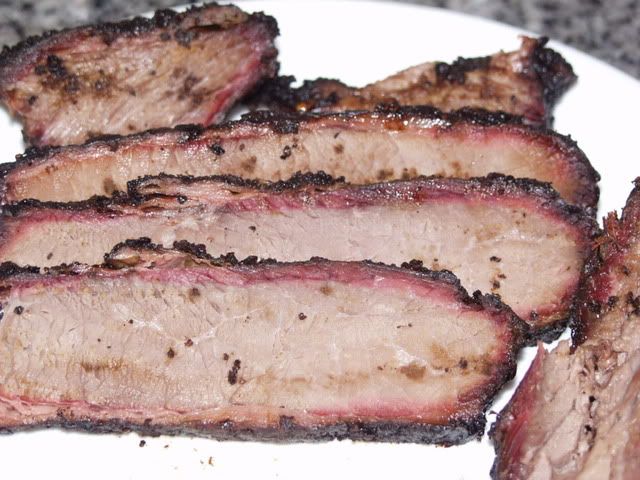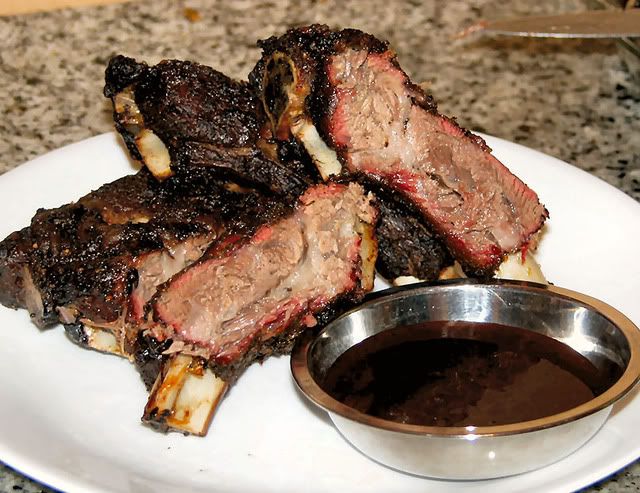Anyway, there are no photos, but, there is a recipe.
-->
Barbecued Albacore
3 to 5 lbs. Albacore loins – cut into pieces no thicker than 2” and 3”w x 6” to 8” l
Bacon – preferably without the nitrate/nitrite (less salty)
Rub:
1 Valencia Orange
1 Lime
Japanese shoyu
3 Garlic cloves
1 large knuckle Ginger
Sesame Oil
Kosher salt
Black Pepper
3 Green Onion
Honey
Sake
Marinade:
above ingredients reserved from the rub
Mirin
Sesame Oil
Juice squeezed from the lime and orange
Shoyu
This is a ‘to taste’* recipe. Albacore can be extremely mild with just a hint of fish, or it can be stronger. Also, the belly flap, collar area, and dark meat (obvious upon inspection) can be quite fishy. Adjust your ingredients to accommodate the strength of the fish. The stronger tasting meat tends to have more blood and fat. This fat prevents the flesh from absorbing the rub and marinade as readily. Add more aromatics, herbs, and spices to your marinade and make the rub stronger. You can also let the rub and marinade sit on the flesh for a longer period.
Use a microplane and shave off the rind of half the orange and half the lime. Crush the garlic with the blade of the knife, sprinkle with a pinch of salt, and scrape the knife over the garlic to make a paste. Slice and chop the ginger, then scrape with the knife to make paste. Cut off the green tops of the green onion and discard. Finely slice the white parts of the green onion. Chop and scrape into paste. Again, use a pinch of salt on both the ginger and green onion to facilitate making paste. Note that the lime and orange rind should not overpower the other aromatics, but add a fruit/floral undertone to what amounts to teriyaki flavoring. Place these ingredients in a mortar. Add the sesame oil, honey, sake, shoyu, black pepper, and salt. Grind with the pestle until the paste appears homogeneous. Note that this will not be smooth like toothpaste, but will have a slightly gritty feel. The black pepper, ginger, and rinds will not grind completely into paste. Set aside some of this rub. Use the rest to rub onto all sides of the albacore. This is firm fish and not easily bruised, so rub the paste thoroughly onto the fish. Place the fish into a steel or glass baking dish with 1” or higher sides. The pan should accommodate the fish with an eighth inch to spare around each piece of fish. Set this aside while making the marinade. Also, separate the bacon and rub/toss/mush together with the rub. Place it between the fish. The fish should sit with the rub for 20 to 30 minutes at a cool room temperature.
Place the reserved rub ingredients in a non-plastic bowl. Squeeze the juices from the lime half and the orange half into the bowl. Add mirin, shoyu, and more sesame oil. Whisk this together and taste. This marinade should have a slightly sweet and salty flavor. Again, the rinds should send a citrus floral note to the back of the palate after the initial teriyaki sesame flavor. Add honey bit by bit until you can just taste the sweetness. Too much sugar can burn and create an off taste. Pour the marinade gently over and between the fish pieces and let sit for 20 to 30 minutes reserving some marinade for later. Touch the fish, and if it is still cold you can leave it out, otherwise, refrigerate during the marinating process. Start the barbecue. I used a Weber kettle and a large chimney of Lazzari charcoal.
Albacore is a dense fish, so you can’t really use a hot and fast grill, unless you want seared/charred on the outside and raw on the inside. This recipe is for cooked/cooked albacore, so I used indirect grilling. Place the lit charcoal on the bottom grate and arrange .
Wrap each piece of fish with the bacon. Be generous, because the bacon keeps the fish from burning on the bottom and keeps it moist. I wrap the bacon barber pole style, and anchor both ends with a toothpick. Some longer pieces require two strips. Place the bacon wrapped fish on either 1 layer of heavy duty foil or a double layer of regular foil, again to protect the bottom of the fish. Begin cooking the fish, turning to insure the thicker pieces and every surface of the bacon is cooking. Periodically brush the reserve marinade over the fish. Once the sides and ends look cooked and the fish has started to firm up (half way to two thirds through the cooking process) take them off the foil, brush again with marinade and place directly on the grate. Again, check frequently and turn the fish. The fish will begin to glaze from the honey and sugar in the marinade and the bacon will get a bit crusty. The fish is done once it has a teriyaki color, slightly shiny glaze, and some char on the high points and edges. Cut it open to make sure its cooked through.


















 . Closed up the bottom vents a bit, dropped it to 400F and it went like that for the entire cook. Done and ready for action, look at that crispy, spicy skin.
. Closed up the bottom vents a bit, dropped it to 400F and it went like that for the entire cook. Done and ready for action, look at that crispy, spicy skin.












